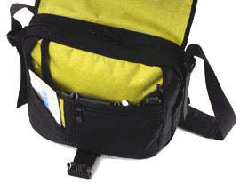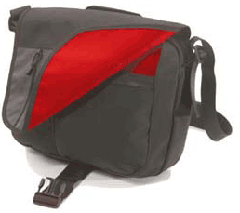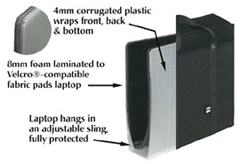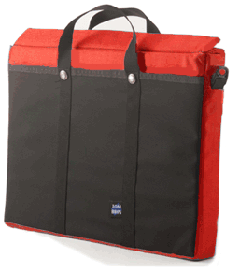Review: ID Bag and Brain Cell
ID Messenger Bag
Brain Cell
I have to offer a disclaimer: I’m an avid motorcyclist and bicyclist, and I often find it necessary to tote my 15" TiBook along with me. I feel most comfortable with a hard case protecting my ’Book, and until someone hands me $2,000 or a spare PowerBook to do some impact/crash testing on, I’m not going to trust soft-sided cases a whole lot. Right now, my hard-sided Bob-L-Bee Megalopolis bag is providing me with peace of mind in case of a crash, and as good as the ID/Brain Cell combination is, I can’t see it replacing the Megalopolis any time soon.

ID Messenger Bag

ID Messenger Bag
That being said, the ID bag is easily the best messenger bag I’ve ever seen or used. The $85 bag by itself is a bit pricey—I’ve seen similar quality backpacks of much greater functionality and capacity, if not style, for as much as $30 less—but when the $50 Brain Cell insert is added on, the combination becomes a good value and a very stylish laptop bag to boot. Perhaps the most appealing feature of the ID bag is that it doesn’t scream “I’m carrying a laptop” like many such bags do. If you’re a student or commute through less-than-savory neighborhoods, you’ll likely enjoy this aspect of the bag’s design. If you’re upper management, this bag is probably too “hip” for you, with its range of stylish colors and suit-wrinkling one-shoulder design. Besides, you wanted black leather, right? :-)
Its waist/hip belt is the only one I’ve ever seen on a messenger bag, and it makes this bag nearly as comfortable as a backpack for long-term wear. (I must admit I don’t prefer its off-balance weight distribution and occasional shifting when riding my motorcycle, however.) Its biggest drawback, in my eyes, is in the adjusters on the shoulder strap. There are two of them, which is good—a single mid-strap adjuster is typical on cheaper bags. Unfortunately, they’re extremely difficult to adjust without removing the bag, though the upside to this is that they are virtually guaranteed never to slip once adjusted to your liking. The strap is fully replaceable, though the downside to this is that it can also be removed entirely from one side of the bag by accident during adjustment.
Pockets and storage compartments are in abundance on most laptop bags, and the ID is no exception. A zippered external pocket on the main flap provides storage for a portable CD player or something similar, while an open pocket on the back side provides a convenient place for a few file folders or papers to ride. Opening the substantial clip and flipping back the flap reveals another 8" by 8" zippered pocket; an open-top half-pocket; ample storage for writing utensils, a PDA, iPod, and/or a cell phone; a key clip; and the double zipper leading to the main compartment.
The main compartment can be used to carry a laptop on its own, but I highly recommend the purchase of a Brain Cell, a padded, hard-sided case that clips into the main compartment. Sized for specific laptops (see the Fit List for specifics; the ID will swallow a size 4 or 5 Brain Cell but nothing larger), it provides a soft interior to avoid scratching and an added measure of protection against bumps. Removing the Brain Cell (a worthwhile purchase in its own right, even without a Tom Bihn bag to carry it) from the ID is a simple matter of undoing two plastic clips and lifting the inner bag out via its handles.

Brain Cell
The Brain Cell deserves further comment. While Tom Bihn’s larger bags are designed to integrate perfectly with it, the Brain Cell can stand on its own as a sort of “laptop purse.” A Brain Cell can also be combined with nearly any other bag or pack to provide an additional measure of protection for the laptop inside. The Bob-L-Bee Megalopolis that I use for most laptop transportation tasks lacks good internal protection for my TiBook, but the Brain Cell picks up where the Megalopolis leaves off and provides excellent (if somewhat snug) protection inside the pack itself. If I’m merely walking across campus, I can toss the Brain Cell in my day pack and presto!—my backpack instantly becomes a padded laptop bag. The Brain Cell also works well inside briefcases, so you executive types can still use it. :-)

Brain Cell
When my Wall Street was my main laptop, I carried—or, rather, lugged—around a bag so full of accessories I once joked that my bag was worth more than my car. The ID bag is not such a beast, and I no longer need my laptop bag to be suitcase-like in its storage capability. There’s plenty of room here for an extra battery or two, but PowerBook G3 owners with multiple expansion bay devices would be better served by a larger, more pocket-laden bag. Even with a TiBook and minimal extras, the ID bag gets a bit tight with an AC adapter as bulky as the infamous Yo-Yo. If you’re the type who carries a laptop with its associated pile of accessories, a couple binders of notes for class, and maybe an iPod or portable CD player every day, you might want to consider a bigger bag. Once loaded with a laptop and accessories, a 2" binder or a couple three-subject notebooks are probably all that you’ll manage to cram in.
The bottom line? Techno-junkies with scores of accessories or folks who prefer the more traditional backpack style should consider something other than the ID as their main case. Those of you looking for a well-padded, stylish laptop carrier with plenty of room for the essentials have found the perfect bag. No matter which category you’re in, though, you’ll find a use for the top-notch Brain Cell sleeve.


Reader Comments (0)
Add A Comment